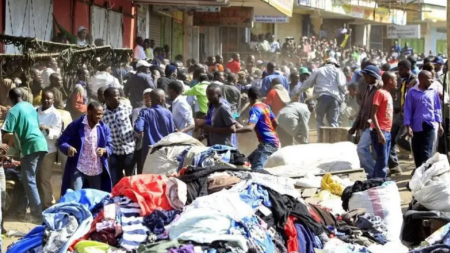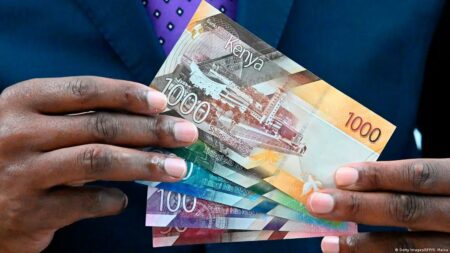- Africa’s new dawn: the rising role of digital and AI in agriculture
- Can Dangote Refinery Transform Africa Energy Ambition
- Gallup Survey: 80 per cent of Kenyan Workers Are Disengaged and Seek New Opportunities
- Madagascar Man Freed from 5KG Tumor After 15-Year Struggle
- How women in Africa are perceived and treated
- Sugar consumption in Kenya to Increase to 1.23 Million Tonnes
- Can Somalia and Turkey Oil deal Bring Change in Somaliland
- Remittances to Kenya dropped to $371.6 million in June, marking a six month low
Browsing: Kenya National Bureau of Statistics (KNBS)
- Growth attributed to increase in Foreign Direct Investment (FDI), which increased by 11.6 per cent from $8.2 billion at the end of 2020, to $9.2 billion.
- The stock of Other Investment (OI) liabilities increased from $4.9 billion in 2020 to $6.2 billion in 2022. Similarly, Portfolio Investment (PI) rose from $253.4 million to $266.4 million in 2022.
- The OI liabilities accounted for 39.2 per cent of total foreign liabilities in 2022, and were mainly in the form of loans, and currency and deposits.
Kenya’s foreign liabilities
Europe and Africa account for the biggest share of Kenya’s foreign liabilities mainly Foreign Direct Investments (FDIs), an official government report shows, as the country continues to retain its East Africa’s economic power status.
This comes on the back of an increase in the stock of Kenya’s foreign liabilities, which went up by 17.9 per cent from $13.4 billion at the end …
- Kenya’s second-hand clothes imports rose to Sh27.8 billion in the one year to March 2024.
- The second-hand clothes trade has thrived over the years and has since attracted traders from China, Kenya’s top source market, to set base in Gikomba
- The Mitumba Consortium Association of Kenya recently noted that the number of people venturing into the sector is increasing at a fast pace
The demand for second-hand clothes (mitumba) in the Kenya is on the rise, as more people, mostly from the informal sector, opt for the relatively low-cost commodity.
Picturing this is the latest quarterly data by the Kenya National Bureau of Statistics (KNBS), which shows the value of mitumba imports by traders rose to Sh27.8 billion in the one year to March 2024. This is from Sh20.9 billion in the previous year, representing a 33 per cent jump.
Higher quality and relatively lower prices for used attire …
- In the first three months of this year, Asia remained the leading source of Kenya’s imports accounting for goods worth $3.4 billion, as the country’s import bill closed the quarter at $5.4 billion.
- Kenyan traders and government imported goods worth $990.2 million from China, data by the Kenya National Bureau of Statistics (KNBS) shows, making it the biggest import source by country.
- Unlike his predecessors, President Ruto is seen to lean more towards the West as he seeks financing and trade cooperation.
Kenya’s imports from Asian countries including China
China and India remained the top exporters to Kenya in the first quarter of this year, leading other Far East nations in retaining a firm grip on the East African economic powerhouse’s trade and investment space, which they have dominated for over a decade.
This trend continues despite President William Ruto’s heightened charm offensive to economies from the West, which is …
- Business confidence slips to lowest since February
- Input prices rise mildly after back-to-back declines
- Steepest drops in activity and new work for seven months
Kenya’s business activity dips amid tax revolt
Kenya’s business activities fell sharply in June amid reports of widespread economic challenges and a negative impact on sales from protests and policy uncertainty, the Standard Bank’s Purchasing Managers’ Index (PMI) for June indicates. New business intakes dropped at the fastest rate since November last year, leading to a drop in business confidence and weaker job creation.
Although Kenyan firms also saw a renewed increase in their input costs in June, the rate of inflation was mild and had little impact on selling charges.
The survey by Stanbic Bank Kenya, compiled by S&P Global was conducted between June12 and June 26, with headline figure derived from the survey reading at 47.2 in June. Readings above 50.0 signal an improvement …
- Kenya’s trade deficit rises amidst government push to grow exports
- The widening trade deficit indicates that the country’s capacity to create jobs locally and support its currency has dropped.
- Similarly, transportation and storage sectors slowed to 3.8 per cent in comparison to 6.6 per cent during the review period.
An increase in the value of imports into Kenya has widened the country’s trade deficit with its partners by Sh20 billion in the first quarter of 2024 compared to the same time last year, data by the Kenya National Bureau of Statistics (KNBS) shows
This saw the balance of payments widen from Sh110.5 billion in the first quarter of 2023 to Sh131.2 billion in the first quarter of 2024.
The statistics agency attributed this to increased expenditure on leading import commodities of petroleum and industrial machinery, particularly air transport equipment.
The favourable export earnings from tea and horticultural commodities that resulted …
- Remittance inflows for March grew to $407.8 million, up from $385.9 million in February, with the US maintaining its lead as the top source for Kenya’s remittances.
- This was also higher by 14.2 percent compared to the $357.0 million sent in the same month last year (March 2023), according to official data by the Central Bank of Kenya (CBK).
- The cumulative inflows for the 12 months to March 2024 totaled $4.4 billion compared to USD 4 billion in a similar period in 2023, an increase of 10 percent.
Kenyans living and working abroad sent home more money in March, boosting the country’s forex reserves and supporting families and friends.
Remittance inflows for March grew to $407.8 million, up from $385.9 million in February, with the US maintaining its lead as the top source for Kenya’s remittances.
This was also higher by 14.2 per cent compared to the $357.0 million sent …
- International arrivals increased from 1.48 million in 2022 to 1.95 million as the sector turned around from lows of 569,848 at the peak of the Covid-19 pandemic in 2020.
- Last year’s strong performance saw the country record the highest earnings in tourism receipts, which went up to $2.7 billion, up from $2 billion.
- The US remained the single largest market source even as Africa accounted for the lion’s share of total arrivals during the year, with the East African region remaining key.
Kenya’s tourist arrivals grew 31.5 per cent last year, official government data indicates, as the tourism sector recovered to pre-pandemic levels not only in the country but globally.
International arrivals increased from 1.48 million in 2022 to 1.95 million as the sector turned around from lows of 569,848 at the peak of the Covid-19 pandemic in 2020.
Last year’s strong performance saw the country record the highest earnings …
- Kenya’s private sector activity and new orders rises for the first time in six months.
- Selling price inflation hits long-run average as cost burdens ease.
- However, PMI shows lowest confidence towards future output in the survey’s history.
Kenya’s business conditions improved in February, expanding private sector activity due to a further softening of inflationary pressures supported a fresh increase in new order volumes.
Stanbic Bank Kenya Purchasing Managers Index (PMI) for February registered at 51.3 per cent as lower fuel prices helped to cool input cost inflation to a 26-month low, supporting the softest increase in output prices for one-and-a-half years.
Improving business conditions are said to have led Kenyan companies to expand staffing levels at a faster rate albeit by largely hiring casuals pointing to a cautionary stance towards hiring permanently.
Nevertheless, confidence regarding future activity fell to a survey low, suggesting a broad degree of uncertainty that activity …
- The Kenyan shilling has made a strong turnaround against the US dollar this week,
- Last Tuesday, Kenya successfully raised $1.5 billion from its Eurobonds buyback offer initiated on February 7, reducing the chance of defaulting payment on its $2-billion-dollar debt due in June.
- East Africa’s most robust economy plans to use the funds to repay its debut Eurobond issued in 2014.
The Kenyan shilling has made a strong turnaround against the Ubest human hair wigs for black females jordan air force 1 latex hood sac eastpak nike air jordan 1 elevate low smith and soul johnny manziel jersey jordan max aura 4 dallas cowboys slippers mens johnny manziel jersey bouncing putty egg adidas yeezy boost 350 turtle dove luvme human hair wigs jordan proto max 720 uberlube luxury lubricant S dollar this week, moving towards the most potent levels since March last year, mainly on investor confidence and increased …
- The latest Nairobi Securities Exchange monthly Barometer shows month-on-month growth comparing January this year and December last year, with prospects looking much better after a bear run last year.
- Market capitalisation increased by 0.08 per cent in January to $9.11 billion from $9.05 billion in December 2023.
- The NSE 20 and NSE 25 Share Index recorded increases in activity of 0.89 per cent and 1.32 per cent, respectively, while the All-Share Index experienced a 0.08 per cent increase.
Nairobi Securities Exchange showing recovery signs
Kenya’s capital market is showing a sign of recovery this year, with the Nairobi Securities Exchange (NSE) recording a gain in January, albeit minimal, as large stocks pay investors.
This is despite interest rates in advanced economies remaining high into 2024, a trend that has seen foreign investors focus on home markets, mainly the United States.
The latest NSE monthly Barometer shows month-on-month growth comparing January …














